Brian May on 9 Queen guitars that aren't his Red Special (plus his Vox AC-30)
From the archive: The guitar legend on the electrics, acoustics and amps that also helped make Queen tick

He may be forever associated with the Red Special, but Queen's Brian May has used plenty of other guitars during his glittering career. We were granted unprecedented access to The Vault – May’s storage facility, which houses some true gems from the band’s earliest days…
In the history of the rock guitar, Queen’s Brian May is surely unique in that he has used just one instrument for pretty much his entire career, both in the recording studio and onstage. What’s more, it’s famously a DIY guitar that he built in a shed at the bottom of his garden. Those with just a passing interest in the band’s output will find it difficult to believe that the guitar sounds they’re hearing all came from a single instrument.
Even Eddie Van Halen, probably the only other guitarist to have enjoyed the same level of stadium-filling success playing an instrument he made himself, jettisoned his striped-up Frankenstein when he finally threw in his lot with Ernie Ball.
Brian still uses his Red Special, but as fascinating as the story is, we’re not here to talk about it. We’re interested in the other guitars Brian has turned to when he couldn’t get the right sound from his regular set-up.
Join us as we explore The Vault, reacquainting ourselves with the lesser known guitars that wrote their own footnotes in Queen’s canon during their brief moments in the spotlight.
John Birch Replica
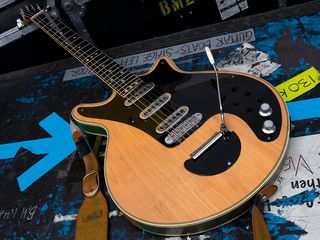
John Birch was a noted luthier based in Birmingham who, among other things, was responsible for the Super Yob famously used by Slade’s Dave Hill. According to the Queen Live concert listing, Brian broke the Replica into three pieces during a show in New Jersey in 1982; it was repaired by Suffolk luthier Andrew Guyton in 2006.
Brian May: “I suppose you know the story of its demise? Did I throw it over the amps in a fit of pique? Well, obviously I would never do that… [laughs]. But yes, I think that’s what happened.
Get the MusicRadar Newsletter
Want all the hottest music and gear news, reviews, deals, features and more, direct to your inbox? Sign up here.
“I met John through Tony Iommi – I hate to think how long ago – and at that point I had no proper spare, which was a very difficult situation to be in, because if I broke a string I’d have to pick up the Stratocaster or Les Paul, which would sound totally different from my guitar.
“So we came up with the idea of making a replica of my guitar and I had three spare pickups that I’d bought as back-ups, so he built it around those. There were problems [laughs] – it turned out that the pickups didn’t have the warmth that mine had andthe guitar was made of different materials, so it really didn’t have the sustain.
"The tremolo wasn’t as accurate and the neck was a lot thinner, because it was regarded as insane to make a neck as thick as mine.It was closer than the Gibson or the Fender to sounding like my guitar, but it didn’t really fulfil the job very well.
“I used to break a lot of strings. I suppose you get carried away with adrenaline and squeeze things further than you would otherwise. So yes, I’d pick up this guitar and it did okay, but it wasn’t quite there and that did frustrate me a bit. Having said that, it was a nice piece of work.”
1967 Fender Esquire
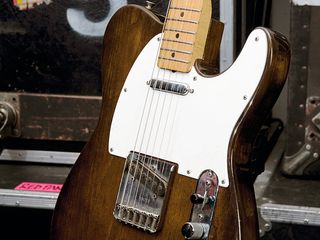
It will be news to most Queen fans, but this guitar isn’t actually a 1954 Esquire, as has often been reported down the years. It’s owned by Queen drummer Roger Taylor, who tells us that he used it on the track Sheer Heart Attack himself, but the four-bolt neck plate’s serial number dates the body to early 1967.
However, the neck is almost certainly from later than that (it’s missing its gold transition logo for a start) and various other details lead us to believe that the guitar comprises parts from several different instruments.
Brian May: “I never tried [recording Crazy Little Thing Called Love] with the Red Special. What happened was that we were sitting around talking about what we were going to do with the song and I said that I thought it needed that period sound – the James Burton Tele sound.
"I said to [producer] Mack that my guitar was pretty good at making a sound like a Tele, but he just looked at me and said, If you want it to sound like a Telecaster, why don’t you just use a Telecaster?
“Roger just happened to have this lovely old thing lying around, so I picked it up, plugged it in, and it worked. The amp? I don’t think it was a Boogie… the honest truth is that I’d use whatever was lying around. I thought I’d used a Fender amp, actually, but I wouldn’t swear to it.”
Ovation Pacemaker 1615 12-string
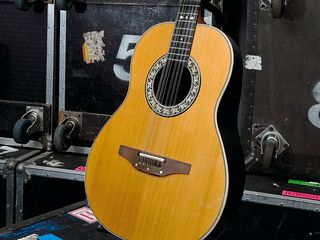
Brian still has several 1615s and they were a staple of live shows from 1977 to 1986, most notably for use during Love Of My Life, ’39 and the rhythm part in the first section of Crazy Little Thing…
Brian May: “It’s nice, stable and didn’t give much trouble tuning-wise. On the record, Love Of My Life is very piano-based and we wanted to do it live, but it would have been fiddly on the piano. So I suggested to Freddie that just he and I should do it and I picked up the 12-string. I kind of evolved ways of making it do what I wanted, so it became the guitar I used for that song.
"I string it upside down, with the lighter strings on the treble side.That means that when I’m picking with my fingers rather than the thumb, I’m picking the high strings, so you can play tunes on it a bit more easily.”
1978 Fender Telecaster
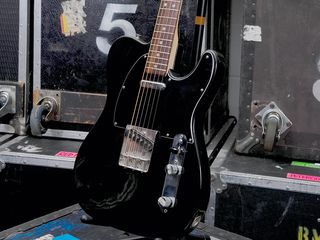
Arguably the most familiar of Brian’s ‘other’ electrics, this stock Tele is used when Crazy Little Thing Called Love is played live. The song was first performed in Dublin on 22 November 1979 and is a mainstay of the set.
Brian May: “I honestly can’t remember where it came from… On the road, if I was was in LA, if there was time and it was a nice day, I’d go down to Guitar Center to play around with guitars, find something I could fall in love with. But normally I was too busy, so I think what happened was that I just asked someone to go get me a couple of Teles.
"Changing guitars mid-song is fine if you rehearse. It’s like a handshake, you have to know where the other guy’s hand is going to be. I’d give him one guitar and he’d give me the other with the strap taut and you’d sort of leap into it. It’s a procedure that you learn and that’s how I do it. It’s pretty foolproof, unless you lose your nerve and panic!”
Sheltone banjo ukulele
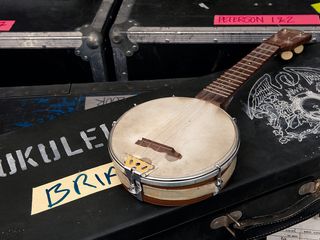
A Japanese-made ukulele banjo that has both its rosewood bridge and tailpiece propped up by old sixpences. Brian used it onstage for the song Bring Back That Leroy Brown, taken from the 1974 album Sheer Heart Attack.
Brian May: “I have an original George Formby ukulele that my dad had with him all through the war and I have a feeling that’s the one I would have used on the record. I did have a selection of them in there, but this ukulele banjo is certainly the one I used all the time on tour.
"It used to have a piece of foam around it so I could slot it on top of the guitar. It was definitely fun to be able to throw that in, it was the last thing anyone was expecting at the time.”
Gibson Chet Atkins CE
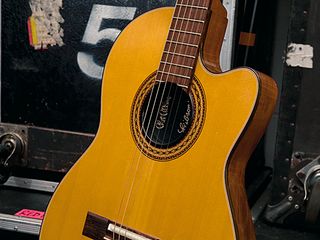
Introduced by Gibson in 1982, this nylon-strung electro-acoustic classic possesses a thinline body that also features tone chambers, which enhances the performance to an extent, even though it has very limited acoustic properties when unplugged. Brian used it on every date of 1986’s Magic Tour for Is This The World We Created?.
Brian May: “I used that live for Who Wants To Live Forever and I have a feeling that’s the guitar on the record too, but I wouldn’t swear to it. It has that lovely mellow, gut string sound. When we came across that guitar it was quite a revelation as trying to mic up acoustic guitars on stage is a nightmare, and it worked really well.”
Burns Double Six 12-string
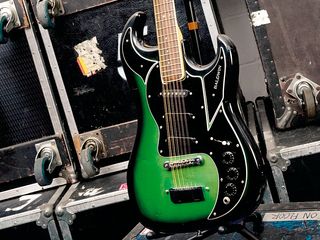
A 1967 model, this 12-string electric features a trio of traditional Strat-style single-coils rather than the Tri-Sonics that would have originally featured in the spec.
Brian May: “I used this on Long Away. Funnily enough I think I bought it because I liked the pickups, but I fell in love with the guitar once I started playing around with it and the song materialised. The guitar actually inspired the riff that powers the song.
“We have played Long Away live occasionally, in Japan I think, and we did it recently with Taylor Hawkins’ band (The Coattail Riders). I should have said no because I’m rusty in those areas, but Taylor wanted to do the song and it was fun. It’s a bit of a fiddly song to play live; most of the stuff that works live is the stuff you can play without too much thought."
Most famous appearance: Long Away (A Day At The Races, 1976)
'It's A Hard Life' Skull & Bones custom
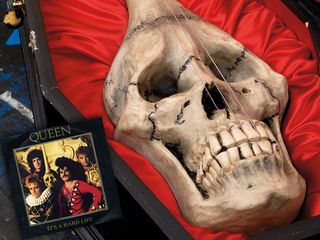
It's A Hard Life was a video conceived in its entirety by Freddie Mercury, which saw all four members clad in a variety of outlandish costumes. Mercury’s resembled a giant red prawn and neither Brian nor Roger Taylor, both marvellously out of their respective comfort zones, have any particular affection for the finished film.
Brian May: “Well, I commissioned it. I remember making a little sketch of the guitar I’d like for the video and somebody made it. It was a film props company and it was only intended to be a prop, never to be played seriously… it did the job at the time.
“I look back at the video more fondly from distance; time mellows everything! Freddie had a good scheme for it – the irony of having a hard life when you’re surrounded by luxury, which is what people think happens with rock stars. So it was a humorous take on It’s A Hard Life.
“But for us it wasn’t a particularly fun thing to do, because you’re basically just an extra in your own video, which often happens with these things. You know, you sit around all day waiting for your shot and it’s not a very creative exercise.”
1963 Vox AC30 Bass
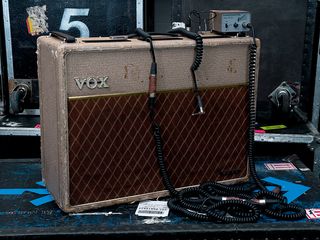
Brian has often recounted the story of how, long before Queen, he’d formulated his ideal guitar sound in his head. It was only when he discovered Taste and Rory Gallagher, who used a single AC30 driven by a Dallas Rangemaster treble booster, that he knew how to proceed.
Here’s how Brian acquired his very first AC30s: “I went with Tim Staffell, who was our singer in Smile, and Roger I think, to a shop called Take Five in Tin Pan Alley that was full of second hand amps, including a few AC30s.
"By that time I had a Rangemaster treble booster – I thought that if it worked for Rory it would work for me – so we pulled a few out, plugged in, and there was the sound.
“I traded in my Burns transistor 60-watt amp and bought two 30-watt AC30s.They were very beaten up but sounded perfect, with that deep, throaty sound, and that was it forevermore for me.”
Pictured is a recreation of that early set-up, including a 1963 Vox AC30 Bass and Brian’s original Rangemaster. The only anachronism is the 60-foot long curly lead that Brian used on 1986’s Magic Tour, certainly at Wembley Stadium and, presumably, also at Queen’s final show at Knebworth Park on 9 August.
Simon Bradley is a guitar and especially rock guitar expert who worked for Guitarist magazine and has in the past contributed to world-leading music and guitar titles like MusicRadar (obviously), Guitarist, Guitar World and Louder. What he doesn't know about Brian May's playing and, especially, the Red Special, isn't worth knowing.

“This supercharged amp-in-a-box pulls no punches in channeling the hallmark haymaker that inspired it”: Keeley Electronics and Sweetwater team up for exclusive $99 fuzz, overdrive/distortion and reverb pedal collection

“There’s something about the harmonics of a V8 that’s just mind-blowingly badass and powerful sounding”: Mesa/Boogie founder Randall Smith on how his high-gain amp designs were influenced by hotrodded muscle cars
Most Popular





